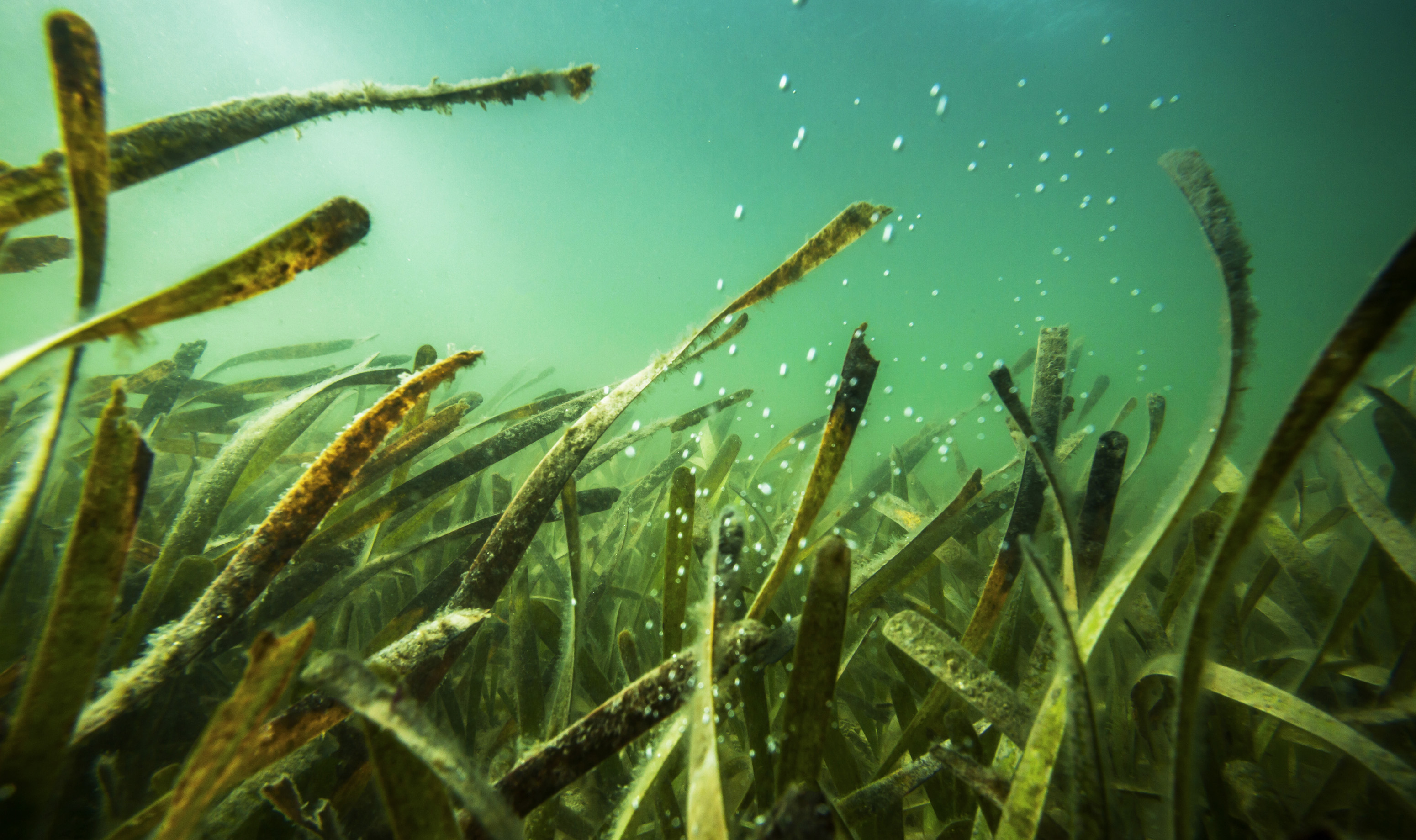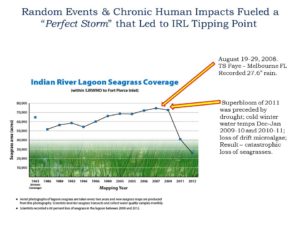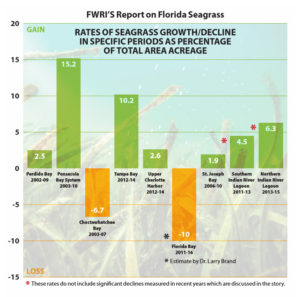June 07, 2017
By Florida Sportsman Editor
Florida's seagrasses suffer losses, though Tampa sees regrowth.
 Turtle grass is one of the most abundant and valuable seagrass species in Florida. Photo by Jimmy White.
Turtle grass is one of the most abundant and valuable seagrass species in Florida. Photo by Jimmy White.
Florida's seagrass woes can be illustrated by understanding another familiar, American ecological disaster: the Dust Bowl. Demand for grains boomed in America after WWI and Midwest farmers plowed under native grasses to meet that demand. When the Depression hit, demand fell, and they abandoned those lands. Prolonged drought followed and when the winds hit those soils without the native grasses, the soils literally blew away. The resulting calamity caused mass migrations and economic devastation.
Florida's agricultural and waterway architects have constructed a similar scenario for our state. Instead of land, we have sea. Instead of wind, we get water. Instead of dust, we get algae. It's happened on various scales for the last 50 years in the state with the replumbing of the waterways and Lake Okeechobee, and now it's threatening the health not only of estuaries to the west and east of the lake, again, but also Florida Bay.
In a recent report on changes in the state's seagrass coverage from scientists guided by the Fish and Wildlife Research Institute (FWRI), The Seagrass Integrated Mapping and Monitoring Program details mixed results. Tampa Bay's success in recovering seagrass acreage is a bright spot, a model to follow. Other regions, including Florida Bay, the southwest coast, the Treasure Coast, Choctawhatchee Bay, the Upper Indian River Lagoon and Mosquito Lagoon have not fared well. While seagrass remains stable in central and southern Biscayne Bay, northern Biscayne Bay has recently suffered a severe loss of seagrass coverage in Tuttle basin of grave concern. The report estimates that Florida's approximately 2.2 million acres of seagrasses “provide ecological services worth more than $20 billion a year,” such as fishing, ecotours and other water recreation.

Specific causes of the die-offs vary from region to region. Localized factors may include prop-scarring from boats or disturbances from tropical weather systems that churn waters and smother seagrass with sand or suspended particulates. The big killer of seagrasses is over-nutrification of waters from a variety of sources including runoff, septic tank leakage and phosphorus and nitrogen from land sources. Over-nutrification leads to abundant algae growth, and sustained algae growth can block sunlight necessary for seagrass survival.
“In 2013, we lost about 75 percent of the seagrass with the discharges in Lower Indian River by the St. Lucie Inlet,” says Mark Perry, executive director of the Florida Oceanographic Society on Hutchinson Island. “Whenever we get the freshwater discharges, we lose the seagrass. Not only is there a temporal loss, but there is a longer-term decline in the overall coverage. In one area, it's gone from about 400 acres of coverage in 1970 to about 335 in 2004 to 218 acres in 2016. A lot of the areas that I knew as a kid as lush seagrass are now bare sand bottom.”
Discharges from Lake Okeechobee are also at the heart of Florida Bay's woes, according to Dr. Larry Brand, professor of marine biology at University of Miami's Rosenstiel School. The bay lost about 50,000 acres in the last few years.
“Phosphorus was a problem in the Everglades, but not the main problem in Florida Bay, which was nitrogen, and that's not being pulled out by the stormwater treatment areas. It's getting into the water flow because the soil in the northern Everglades is rich and has high levels of nitrogen, but when there is natural water flow, the nitrogen stays trapped in the soil. When that soil was drained for sugar cane production, the nitrogen is released from the soil when it gets reflooded, and that nitrogen causes the algae blooms that kill the seagrasses. The nitrogen is from the soil, not from fertilizer. “The problem you have now is the water is murky, sediment is anaerobic, and the seagrasses can't stand the higher salinity in the late summer, whereas if the water was healthy they could.”
In short, instead of land we have sea. Instead of wind, we get water. Instead of dust, we get algae.
“In my view,” Brand continues, “to truly restore the Everglades, you have to flood the northern third of the Everglades. Stop subsidizing the sugar industry and you'll stop the release of nitrogen and phosphorus."
In the northern Indian River Lagoon and Mosquito Lagoon, the last few years have also seen a severe crisis. “We had generally improving extent and distribution of seagrass from the late ‘80s up until 2007,” said Duane De Freese, Executive Director of the Indian River Lagoon National Estuary Program. “Then weather events—Tropical Storm Faye in '07, and then 2010 and ‘11s freezing winters, combined with the impact of chronic problems, caused the super bloom in '11. After the El Nino year of '1516, we had a huge bloom, more seagrass loss and a massive fish kill. It's been in recovery mode in 2017, but we're not out of the woods.”
That fish kill mobilized the region's residents. In November of 2016, Brevard County residents passed a half-cent sales tax increase which will produce revenue of about $300 million to be dedicated to Indian River Lagoon restoration.
“The reality is that until we put this system on a severe nutrient diet, we won't see a real recovery,” De Freese said, while noting restoration projects underway in the region, including muck removal, septic to sewer conversion, stormwater reduction and oyster restoration.

Tampa Bay has made a big recovery, meeting and surpassing the Tampa Bay Estuary Program's own goals for improvements in seagrass acreage, says Nanette O'Hara of the organization. According to the state's report, Tampa Bay enjoyed a 10 percent increase in seagrass acreage between '12 and '14, when the latest surveys were assessed. The accomplishments were achieved through municipal, industrial and residential reductions in nutrient outflows to the bay since the 1970s.
“Decades ago, Tampa upgraded its sewage treatment plant, and St. Petersburg rebuilt its reclaimed water system to reuse sewage and waste water for irrigation,” says O'Hara. “Tampa Electric Company invested 100s of millions in technology to reduce emissions from their power plants. The fertilizer industry made improvements like covering their conveyor belts where they'd move their products from ships into factories so it wouldn't blow into the water. Then we have, really, the strictest regulations for use of residential fertilizer in the nation in Tampa and Pinellas County, where it cannot be used or for sale in the summer.
“We still have work to do,” O'Hara says. “Our improvements will be determined by how clear and clean we can keep the water. It's going to take an effort equal to what we've made in the past to do that.”
 Scientists monitoring the health of seagrass beds. Photo: Tampa Bay Estuary Program
Scientists monitoring the health of seagrass beds. Photo: Tampa Bay Estuary Program
Restoring Seagrass
Scientists across the state have for years had success rebuilding damaged and destroyed seagrass beds. Scientists at Florida Oceanographic Society's FOSTER program are developing a new technique which does not require removal of any existing healthy seagrass. They regrow blades of seagrass washed up on beach shorelines and fabricate them into plantable mats. The mats, made of biodegradable materials like coconut thatch, have already been shown to reroot, grow and thrive in test locations in the Indian River Lagoon.
“We use a previously unused resource of seagrass fragments,” says Dr. Vincent Encomio, Director of Scientific Research at FOS. “What we have growing in our lagoon at FOS is lush and healthy. We can use it for replanting, but we plan to continue our citizen-science project with our volunteers." See floridaocean.org. FS
First Published Florida Sportsman Magazine June 2017
